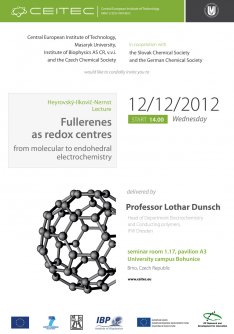The presentation will be focused on the redox behaviour of fullerenes including the matters of the electron transfer through the carbon cage and the reversible charge storage in endohedral fullerenes. Therefore, all CEITEC researchers and students interested in related fields of science are encouraged to come, listen to the excellent lecturer and join the discussion afterwards.
WHEN: 12/12/2012, 14.00
WHERE: seminar room 1.17, pavilion A3, University campus Bohunice, Brno, Czech Republic
Abstract:
The extended π-system in fullerenes is able to undergo reduction and oxidation at low and medium electrode potentials. The stabilisation of charges at fullerene cages is an important point of general and applied studies of fullerenes. In the range of C60 to C84 cages the role of the extension of the π-system and the influence of the isomeric fullerene structure are studied by in situ ESR UV Vis NIR spectroelectrochemistry. As the fullerene π-system can be changed by derivatisation as well it is an important chance to vary the redox behaviour of fullerenes by the addition pattern of substituents shown for different CF3-derivatized fullerenes. Here, general conclusions on the redox behaviour of such fullerenes can be given.
Another version of changing the electronic state of fullerene cages exists in endohedral metallofullerenes (EMF), where the charge at the carbon cage plays an important role in the stabilizing effect of the fullerene itself and its redox states. Here, a new type of redox reaction – the endohedral electron transfer – can be detected. Up to now, there are several EMFs for which an endohedral redox activity has been convincingly proved by both experimental and theoretical studies. Electron transfer to/from endohedral metallo-fullerenes usually leads to population/depopulation of the fullerene-based molecular orbitals. Endohedral redox activity was discovered for selected cluster fullerenes. Their number is continuously increasing with the developments in EMF synthesis and fulfillment of more dedicated studies of their properties. Here, the state-of-the-art in the emerging field of endohedral electrochemistry is described. Representative examples of EMFs are given which exhibit endohedral electro¬chemical activity. Endohedral redox activity also raises fundamental question on the physics of the electron transfer through the carbon cage. Such phenomena as spin-charge separation and spin flow already discovered for EMFs require a detailed analysis. Thus, the matter of reversible charge storage in endohedral fullerenes raises questions of fundamental importance.
Poster to download can be found HERE.










